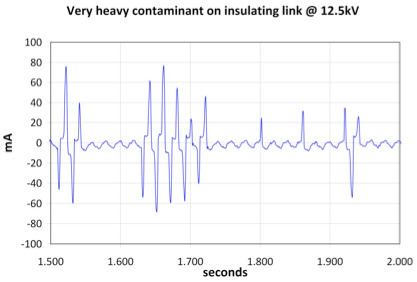 | ||
An insulating link is a device used on the hook of a crane to protect the crane operatives from the danger of electrocution should the crane come into contact with a power line. Insulating links are essentially robust insulators and prevent the flow of electricity from bare, suspended wires through cranes and into personnel working near the crane. Variants of insulating links are also made for specific use in antenna guy wires, and foundry and munitions applications.
Contents
History
The dangers of working near overhead power lines, which have no insulation covering their wires, first became apparent with the electrification of Western countries in the first half of the twentieth century. As early as 1931 there was a patent for an insulator that could be affixed to a crane’s wire rope or chain in order to prevent electrocution. Such early designs, however, proved unreliable because of their inability to operate safely in all construction crane environments.
By 1965 Federal law mandated the use of insulating links on cranes in the United States. However, this requirement was lifted in the 1980s after an investigation found that lethal levels of electric current could pass through the insulating links in use at that time if they were wet or otherwise contaminated. This problem meant that insulating links were not widely used until new designs were developed in the 1990s.
New developments in insulating link technology, that take account of the likelihood of insulating links being used in the typically dirty and wet construction industry environment, meant that the US Government introduced a new law in 2010 that mandates the use of approved insulating links in certain situations. These insulating links must be tested and approved by a Nationally Recognized Testing Laboratory to a standard such as CPLSO-14.
CPLSO-14 has incorporated tests which recognize that the current flowing over a contaminated and wet insulating links has bursts of current trying to jump over "dry bands", as shown in figure 2. Dry banding results from the current passing over the contaminated and moist insulator, heating and drying out the water, usually at points of minimum diameter and radius.
If the burst of current occurs in the vulnerable T wave of the heart cycle then fibrillation may occur. The methodology of analysis used in CPLSO-14 applies the principals from IEC 60479-2, shown in figure 3, to design a testing protocol to determine if the insulating link is safe in the construction crane environment where rain and contamination, SP3, are normative. This method is attributed by IEC 60479-2 to Pratt.
Purpose
Insulating links are needed on cranes and tag lines, (guide ropes), to protect against electric current passing from the power line through the wire rope of the crane and into the personnel working on or near the crane, figure 4. Figure 5 shows the Federal requirements for working close to a power line. The list includes layers of prevention but the only meaningful protection is the insulating link and tag line insulators. Incidents of power line contact are common because of the difficulty the driver of the crane has in distinguishing the thin cable of the power line against the background of the sky.
Accidents involving contact between a power line and a crane are invariably extremely serious, often resulting in extensive injury or the death of crane operative(s). In fact, on average 100 contacts occur each year in the US between a crane and a power line, while 20% of all fatalities in the US construction industry are due to cranes touching power lines. Electrocution because of power line contact is sufficient to cause ventricular fibrillation of the heart, often fatal, while the wound caused by the electric current leaving the body will often remove legs or feet.
Grounding a crane is not effective, since enough current can still pass through crane operatives to be fatal. The only reliable method of protecting people working on or near cranes, in all environments, is to use an insulating link that meets the American National Standard CPLSO-14.
